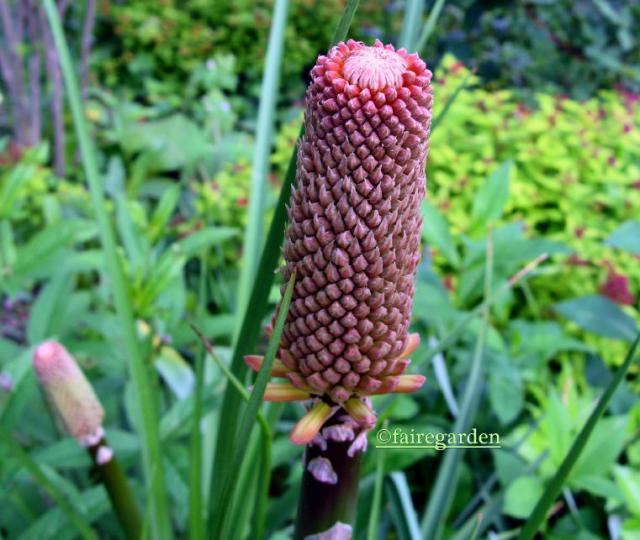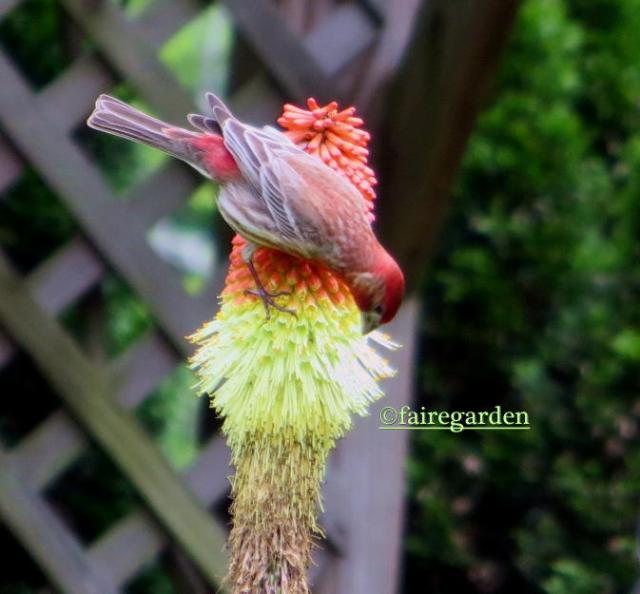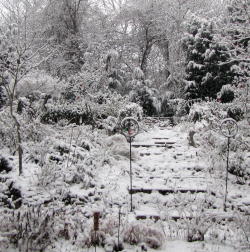
They came with the property. Under the twinings of Japanese honeysuckle, wild grapevine and privet shrubs gone beserk were imposing pointy rosettes of thick dark green. Their identity was unknown, but the cluster was divided and moved to a blank space by the side of the house to wait and see what would develop.

As the stout stalks arose, excitement escalated. As the tops formed titillatingly, there was a hint of what was to come next. Kniphofia ssp. of some sort, most likely Kniphofia caulescens was determined in the big reveal. These had never been seen growing in real life, but had been noticed in catalogs, books and magazine articles. I thought they were more of a tropical plant and was thrilled to be able to grow them here in USDA Zone 7a Southeast Tennessee. As they began to bloom here, several more clusters were noticed around the neighborhood, perhaps the result of friendly passalongs over the years.

These are big plants that need some room to best show off their charms. They have been moved multiple times and at one point were deemed too large to even live here at all. The lot was dug up and given to my daughter Semi to help fill in her hillside that is even steeper than my own slopes. But there must have been a piece of root left in the ground, for the unmistakable foliage rose again from the soil. Thank goodness.

A couple more moves has found the perfect, for now, location to grow these fine fellows, in the Gravel Garden amongst the tall Calamagrostis x acutiflora ‘Karl Foerster’ grasses in the back of the bed. There are some irises in there, as well, Iris germanica ‘Cinnamon Girl’ is showing off at present.

In all the growing spots of the tall flower stalks around here as time has passed, birds have been noted feeding on something unknown as the blooms open from bottom to top, turning from the reddish orange buds to pale yellow petals. Quizically but with gusto, the birds are finding a treat there. Bugs? Seeds? Something.

The finch family, cardinals, goldfinches and male and female purple finches that are featured in these photos, a downy woodpecker and even a hummingbird have been seen this year feasting on the flaming torch like flower heads. The common name of red hot poker is apt, as is torch lily, another moniker. Even stripped bare, the stalks give vertical interest until they are cut down in late winter to make way for new spring growth.
Some plant facts about Kniphofia caulescens:
Meaning: Named for Prof. Johann Hieronymus Kniphof, 18th century botanist
Pronunciation: nip-HOFF-ee-uh
Alternative Pronunciation: nip-HOH-fee-uh
Hardy in USDA Zones 7a to 10b, also listed hardy to Zone 5
Size: 4 to 6 feet tall and wide
Siting: Full sun
Bloom time: mid spring
Drought tolerant, clay tolerant, deer resistant
Acid to neutral soil with good drainage
Native range: is native to the high grassy slopes of South Africa’s Drakensberg Mountains
Propagate by crown offset division

Once bitten by the Kniphofia bug, the search was on for more varieties. So far two Kniphofia uvarias, one white and one a nice yellow, shown above, have been added, from mixed seed grown by Ruth at Mouse Creek nursery, Kniphofia ‘Little Maid’, a diminutive, one foot tall, micro mini in pale yellow and Kniphofia rooperi from Plant Delights Nursery that has yet to bloom after several years in the ground here. The last two species have also been moved to the Gravel Garden for better growing and the better to see you, my dears. If there are future blooms of these, photos might be added to this post, if I can remember to do so.

As you can see, the yellow/red flowers that might be off-putting to some, fit right in with the no rules color scheme of the spring blooming extravaganza here.
Frances









Very pretty and good thing you kept it, too. I tried growing kniphofia a couple times but the plants died young, I think I did not grow them under the suitable conditions. However my aloes blooms splendidly so they are a good substitute.
That is a lovely display of Kniphofia Frances!
This is a fantastic plant. I have never seen birds get on them though. Actually they don’t like it in my garden. Not enough sun I guess. I love the texture of the blooms. They do look tropical.
Frances, the birds on the kniphofia made my morning. They are marvelous plants and I love their red hot colors. They look stellar on your garden steppes. xoxogail
Couldn’t help but be struck by how well your ‘Cinnamon Girl” goes with the Kniphofia…she’s all frilly and girly in comparison to his soldier like simplicity…they make a beautiful couple!
Great shots, Frances.
Beautiful. I’ve tried to grow these beauties without any luck. I really like them, but didn’t know they got so big.
Hi Frances…when I saw the first picture my thought was “how long did you have to wait to get a shot like that”…it’s just wonderful! These look wonderful in your garden. About six years ago someone gave me a small Kniphofia which I planted in the back garden. Now I constantly go back and forth about whether I want to keep it because it looks so “deserty” to me instead of “cottagy”. However, when it blooms it is really pretty, so for now the “keep it” side is winning.
I love Kniphofia but for the life of me can’t figure out why I can’t grow them in Florida! I have great looking foliage but the stalks never come!
Yours are stupendous! Like everyone else who commented, I’m in awe of the shots with the birds! 🙂 Beautiful all around!
I so wish those would grow here! They would look smashing in my corner bed. But alas, they find my corner of Katy inhospitable!
I bought seeds several years ago that did not sprout. I had no idea that they were so large! Your photos urge me to try again or perhaps find them at a nursery. “…lucky with the bird shots.” I think not. Your bird photos are to die for! Thanks so much for brightening our days!
Such a wonderful structural plant, one of the first I bought to put in my gravel garden. I saved seeds from it as well, and this year I have some tiny little babies. I hope mine attracts some birds like yours have.
Hi Frances my friend! Beautiful pictures! I love Kniphofia but as you say they need a rather big spot to grow in. Mine turned out to be missplaced and I digged it up, sad… And I keep wondering if there aren´t any place in our garden where it could fit in?
Kram!!!!
Frances
This blog never stops delighting us. Thanks for sharing so many pretty and interesting garden moments with us here in the North.
Love your pictures! A few years ago we made a trip to Scotland in June and kniphofia were growing and blooming all over the place – in front of businesses, in parks, and in private gardens. As we drove around neighborhoods in Edinburgh, nearly every home had at least some. It was absolutely stunning and unforgettable.
I like it!!! Now I want one. But where will I put it??
I had no idea Kniphofia provides bird food! I’m guessing it must be the seeds. Do you know if that is a purple finch or redpoll?